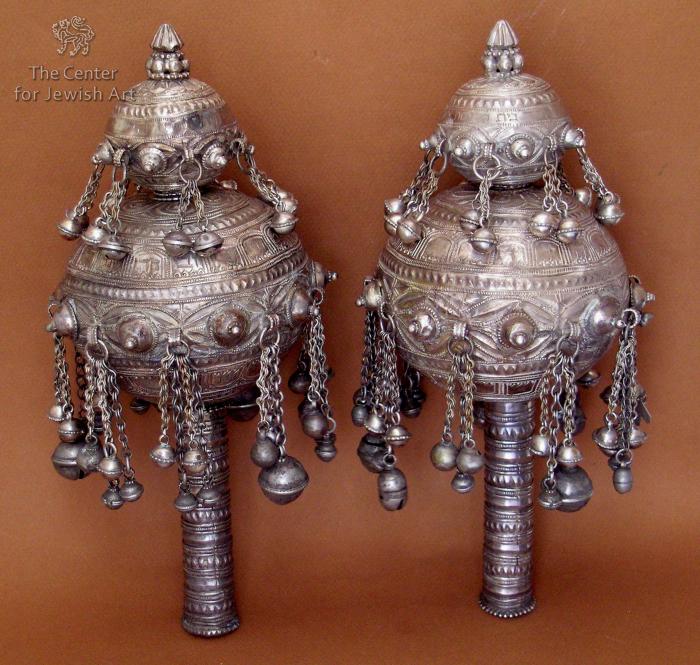Obj. ID: 37106 Torah finials, Aden, circa 1890

sub-set tree:
The following description was prepared by William Gross: The finials evolved from knobs at the upper end of the staves (Atzei Chaim) on which the Torah scroll is wound. Since the shape of the spherical finial recalled that of a fruit, it was called a tappu'aḥ, "apple," among the Jews of Spain and in the Sephardi Diaspora, and a rimmon, "pomegranate," in all other communities.
The earliest known reference to Torah finials occurs in a document from 1159, found in the Cairo Genizah, from which we learn that by the 12th-century finials were already being made of silver and had bells. Around the same time, Maimonides mentions finials in the Mishneh Torah (Hilkhot Sefer Torah 10:4). Despite the variations on the spherical shape which developed over the centuries and the addition of small bells around the main body of the finial, the spherical, fruit-like form was the basic model for the design of finials in Oriental and European communities.
A most significant variation appeared in 15th-century Spain, Italy, and Germany, where the shape of finials was influenced by that of various objects of church ritual, whose design often incorporated architectural motifs, The resulting tower-like structure, which seems to have appeared around the same time in different parts of Europe, became the main type of finial in 18th-century Germany and Italy, as well as Morocco, brought there by Jews expelled from Spain.
This style of Rimmonim is unique to Aden and is done in the style and workmanship of that city and southern Yemen. This type was used as well in combination with a special crown developed in that area, an example of which is in the Israel Museum. This particular example has a dual inscription, one describing the original donation and the other the donation regarding the repair after the Rimmonim had become damaged.
Inscription: Sanctified unto the Lord. {Belonging to} the Synagogue. For the invocation of the soul of Nissim Yosef {son of?} the late Hazi Asrouf. Thanks to the Lord, by my endeavor, I, the "youth", Zvi Me'ir Hemmou, may the Lord sustain and protect him. After all this (?) they (the finials) were damaged and all their bells were lost from them, and we again restored everything. From the money of the honorable woman, Madam............., may she be most blessed of women in tents, daughter of........., may she live a long life, the year 5686 (1926)




